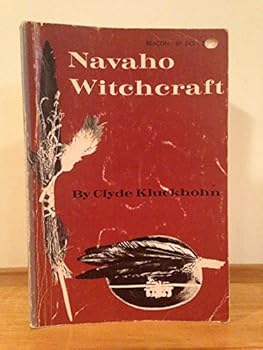Navaho Witchcraft Pa Txt
Select Format
Select Condition 
Book Overview
Witchcraft is defined by Clyde Kluckhohn (1905-60) as "the influencing of events by super-natural techniques that are socially disapproved," and his description and analysis of Navaho ideas and actions related to witchcraft illuminate the ways in which society deals with the ambition for power, the aggressiveness, and the anxiety of its members.
Format:Paperback
Language:English
ISBN:0807046973
ISBN13:9780807046975
Release Date:January 1963
Publisher:Beacon Press (MA)
Length:254 Pages
Weight:0.70 lbs.
Dimensions:0.7" x 5.4" x 8.0"
Customer Reviews
3 ratings
Good Resource for Native American Black Arts
Published by Thriftbooks.com User , 17 years ago
This book is really good for anyone interested in Black Magick according to the Navaho Tradition ( which is also very similar to the Apache Tradition ). The only negative part of this book is that the author doesn't really go into detail on the exact wording of the chants that go along with the Hexes and Curses. Although I feel its understandable why he either chose not to put that in the book or why he wasn't given that kind of information from his contacts. This book is well worth the money for any student of the Occult.
read it if interested in navajos
Published by Thriftbooks.com User , 20 years ago
There is one thing a full-blooded Navajo will never do: talk about "skinwalkers" (witches) who are thought to roam at night doing their nasty business. Talking about witches tells the informant's community that (a) he knows things he shouldn't know (i.e., he is a witch himself) or (b) he becomes liable to the hatred and revenge of witches he talked about. It is a great achievement of Kluckhohn's to have made an exception to this rule - his understanding of the Navajo culture (following 37 years of study), empathy for the people, and understanding of social mores allowed him to obtain the trust of the locals and get information which is jealously guarded and never divulged to non-natives. This book details some of the practices which evolves in parallel to the curing (BLessing Way etc) rituals. There are many parallels with beliefs in other indigenous communities (werewolves, spells etc), especially with those of the neighboring Pueblo tribes.This book's usefulness is in that we get first hand information on Navajos from one of the pioneers in the field of anthropology. The anthropological models used by K. are a bit outdated; for him the fear of witchcraft developed as an instrument of social control which allowed people to channel their hostility in a socially permissive manner (most accused witches tend to be rich men and/or Indians from neighhboring settlements; Hopis were especially feared). The weakness of the book is that K. did not really understand - or practice- Navajo ways. He never attended a single witchcraft ritual, never met a self-confessed witch and his informants lacked knowledge or were sufficiently elusive for his information to be more or less on the level of statistically evaluated hearsay (which used to pass as anthropology and still does). Still, this is a valuable book, a classic, and if you are interested in Navajos you will do well to read the book; it will prepare you for a lot that is unsaid in conversation with them.
Unique monograph on Navajo culture
Published by Thriftbooks.com User , 26 years ago
First published in 1944, Clyde Kluckhohn's Navajo Witchcraft offers a comprehensive analysis of witchcraft tradition in Navajo culture. As the main research source, 93 informants were interviewed by Kluckhohn. Among the sample, 76 people were men, 71 individuals were over fifty years old. It is important to note that 38 individuals were ceremonial practitioners who are skilled navigators of their folk knowledge. Based on the data which has been collected since 1923, the first draft was written in 1938, and it was rewritten several times for content revision and data addition. Navajo witchcraft consists of various techniques of malevolent activity which include "Witchery," "Sorcery," "Wizardry," and "Frenzy Witchcraft." Each technique is employed accordingly to a practitioner's purpose. For example, the flesh of a corpse is used in "Witchery," or Witcheryway to put a curse on an individual. Kluckhohn utilizes a functionalist interpretation method to explain the social validity of Navajo witchcraft. Navajo culture is a scarcity culture because of the semi-arid environment and over-grazing by livestock, making life harder for Navajos. In such living conditions, personal insecurity, intra-group tension, and aggression towards others arise among the members of the society. Kluckhohn argues that witchcraft exists as a channel for an individual's socially suppressed frustrations. Witchcraft is a road to supernatural power and power is a central theme in Navajo world view, therefore, its existence is socially accepted. Kluckhohn hypothesizes that socially accepted witchcraft serves as a remedy for hostility and anxiety, maintaining a social equilibrium in Navajo culture. There have been many criticisms made on the functionalism during this century, and one of the significant criticisms is the over emphasis on social equilibrium. Kluckhohn's functionalist interpretation has its own limitations. His interpretation lacks the consideration for the possibility of oncoming socio-cultural changes in Navajo culture which were made possible by the advancement of technologies in the late twentieth century. Due to such technological advancement, people became more mobile and have more access to various kinds of information and material goods. Consequently people have more alternatives to channel or sublimate their social frustrations. As socio-cultural situations have changed, witchcraft cannot be the only antidote for social frustrations and the only instrument that maintains the social equilibrium. It is indeed an advantage of this monograph however that it is one of the few books which illustrates the "dark side" of Navajo ceremonial tradition. Yet as I have mentioned, there may be a necessity to reinterpret the witchcraft tradition. I would argue that there's a necessity to collect contemporary Navajo views on witchcraft and its practice in order to reinvestigate the validity of witchcraft tradition in today's diverse Navajo society.





